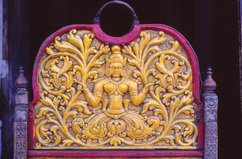Main Menu
AORC Libraries
Composite figures which are part female
Dublin Core
Title
Composite figures (part female) - Narilata
Subject
Symbolism in art (Narilata)
Wood-carving--Gaḍalādeṇi Rajamahā Vihāraya (Kandy, Sri Lanka)
Decorative art
Description
Painted at the two ends of a palanquin or ‘dolava’ used in the annual procession at the Gadaladeniya Vihare in the Kandy district, Sri Lanka, are narilata motifs. This representation is probably a work of the Kandyan period, although the temple itself dates to the 14th century A.D.
Creator
Sirima Kiribamune
Source
Gadaladeniya--Kandy, Sri Lanka
Date
ca. 14th century A.D.
Period of study: 1986-1987
Version: 01/12/2012
Contributor
Co-Author: Seneviratna, Harsha
Technical Officer: Wijesinghe, Lalith
Technical Assistant: Jayasundare, Subhashini
Photographer: Madanayake, I.S.
International Center for Ethnic Studies, Kandy, Sri Lanka
Norwegian Agency for Development Cooperation
American Institute for Sri Lankan Studies, Colombo
Rights
All rights reserved by International Center for Ethnic Studies, Sri Lanka.
Relation
Forms part of Photographic documentation of Women as depicted in early Sri Lankan sculpture and painting / Slide in present collection
Format
JPEG 2000
Language
eng
Type
image
Identifier
PDWESLSP.S.144
Coverage
ce
Collection
Citation
Sirima Kiribamune, "Composite figures (part female) - Narilata," online in Digital Library for International Research Archive, Item #12641, http://www.dlir.org/archive/items/show/12641 (accessed April 20, 2024).














